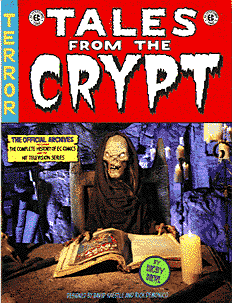





| The Crypt Keeper Says "You'll Just Die Reading It!" by Gary Johnson | |
|
Although few people would have guessed it twenty to thirty years ago, EC has become one of the most influential comic book companies ever, and their fame rests on the comic books they churned out during their brief reign as the champions of comic book horror, from 1950 to 1954. | |
These comic book titles included Weird Science, The Vault of Horror, The Haunt of Fear, Crime SuspenStories, Two-Fisted Tales, and the now famous Tales from the Crypt (thanks to the HBO television series). Many writers and filmmakers (such as Stephen King and Robert Zemeckis) have revealed their debt to EC and talked about reading the comics by flashlight under their bed covers when they were kids--for the grisly, often bloody material in EC Comics made parents cringe (and sometimes become indignant). The fascination with EC, largely old fans now all grown up, has helped spawn a complete line of reprinted EC Comics (thanks to publisher Russ Cochran). | |
And now, thanks to a new book by Digby Diehl,Tales from the Crypt: The Official Archives, we can relive the EC story--from EC's beginning as "Educational Comics" (which changed to "Entertaining Comics" in the late '40s) to the fall of EC, amid the growing pressure from parents and politicians about comic book violence. But the story doesn't end there, for Diehl continues the saga through the history of Tales from the Crypt on film and television.
Along the way, Diehl delivers many tasty pieces of information, such as the story of Max Gaines, the father of William Gaines who would take over ownership of EC after his father died. Max Gaines was one of the most important publishers in the early history of comics, who gave us, among others, Action Comics (which starred Jerry Siegel and Joe Shuster's Superman) and Wonder Woman. Diehl also reveals how Gaines attracted some of the best artists in the business by offering good salaries and artistic freedom.
The Official Archives is a genuinely gorgeous book, which features reproductions of all the comic book covers for Tales from the Crypt and the other horrific offerings in the EC stable: The Vault of Horror, The Haunt of Fear, and Shock SuspenStories. Additional sections give us short bios on all the major EC artists (including Wally Wood, Jack Davis, Harvey Kurtzman, Johnny Craig, Graham Ingels, Al Williamson, George Evans, and many others) and a collection of four great tales, reproduced in color in their entirety. (For the record, these stories include "Lower Berth" by Jack Davis, "The Thing From the Grave" by Al Feldstein, "Horror We? How's Bayou?" by "Ghastly" Graham Ingels, and "The October Game" by Jack Kamen). In addition, we get a previously unpublished story from the EC Picto-Fiction series entitled "The Mother," with artwork by Jack Davis. And throughout the book, we get loads of reproduced artwork culled from the original sources.
As much as I enjoyed the first 150 pages or so of The Official Archives, I have to admit a slight disappointment when the story turns to the HBO series instead. While the pages concentrating on the comic books are gorgeously designed, the television series pages focus on the gore and special effects--like you might expect from gore-zine Fangoria. In these sections the pages become filled with viscera-splattered photographs (a man's head blow in half by a shotgun blast, another man's head half-eaten by maggots, a chainsaw cutting a man in half, etc.) and if that isn't enough, the book designers have added additional drops of blood dripping from the title of each episode name in the Crypt Compendium of Tales television episodes. This obsession with bloody special effects and make-up doesn't do justice to the sly storytelling and bone-chilling suspense offered by the television series and reduce it to little more than a Grand Guignol vehicle.
In addition, when the book turns to the recent Tales from the Crypt movies, the ratio of pages to subject matter strikes me as completely out of proportion. For example, in the comic book artist compendium, Wally Wood (one of the most revered and imitated comic book artists) rates just one page, but Demon Knight, the first feature film by the Tales from the Crypt production company, rates 10 pages!
However, as an introduction to EC's horror line of comics, The Official Archives presents an absorbing story, and the many comic book panels and cover art it contains are certain to astonish readers. In today's comic book world, which is virtually overwhelmed by superheroes, the beautiful and eerie work of the EC artists reveal a whole different type of comic book that sadly is a rare product on today's comic book shelves. And Digby Diehl's text provides an enlightening view of the development of EC and its subsequent run-ins with Dr. Fredric Wertham (a noted psychiatrist who insisted that comics had created a "new pornography of violence") and the U.S. Senate Subcommitte investigation into juvenile delinquency (the book includes a short excerpt from the William Gaines statement before the subcommittee).
The fall of EC amidst cries for comic book censorship makes for a fascinating and tragic story, but luckily EC Comics have survived, thanks to William Gaines' habit of saving all the original artwork, and now the story can be relived by everyone.
Tales from the Crypt: The Official Archives by Digby Diehl, A St. Martin's Press publication, $45.00, hardcover. |



